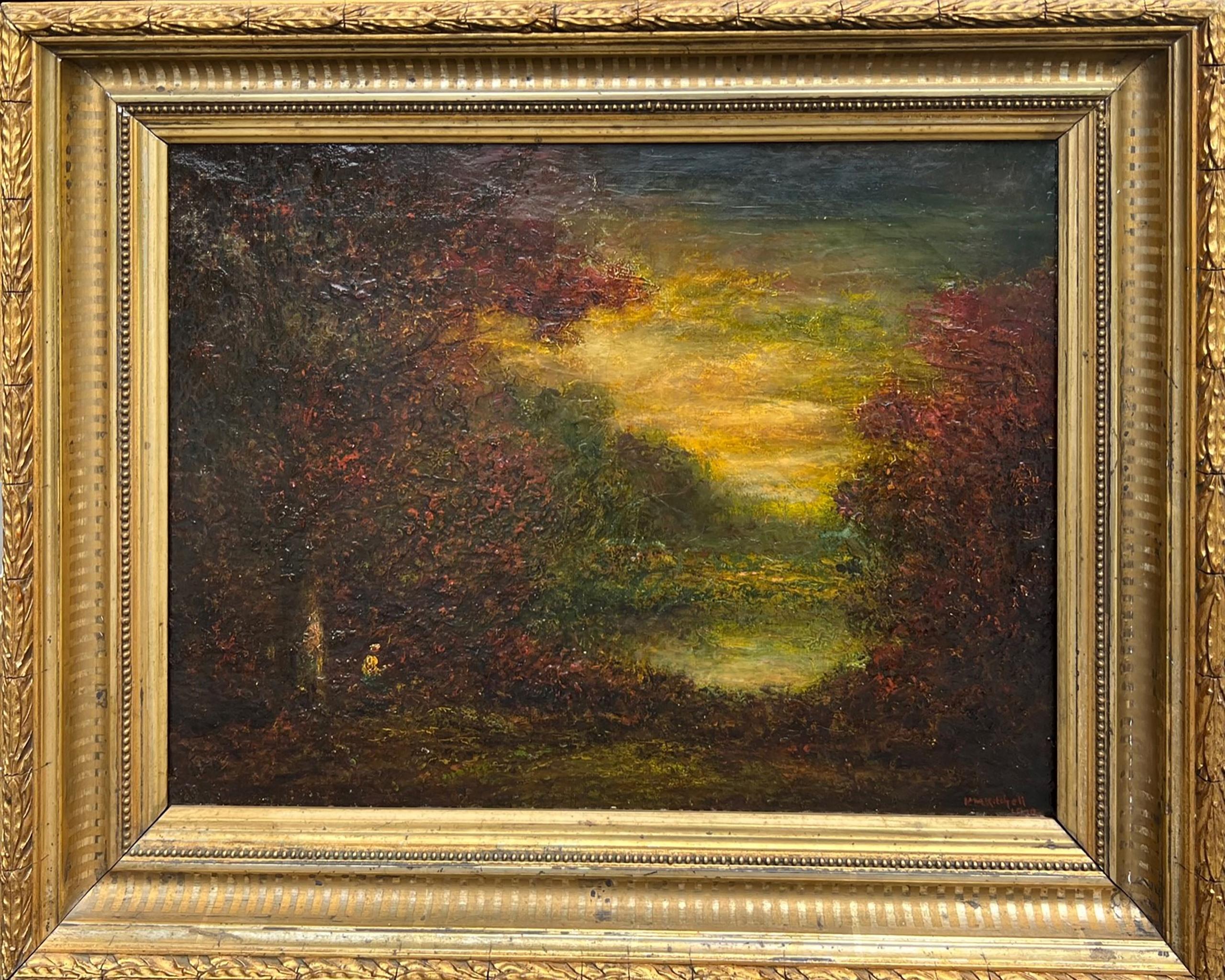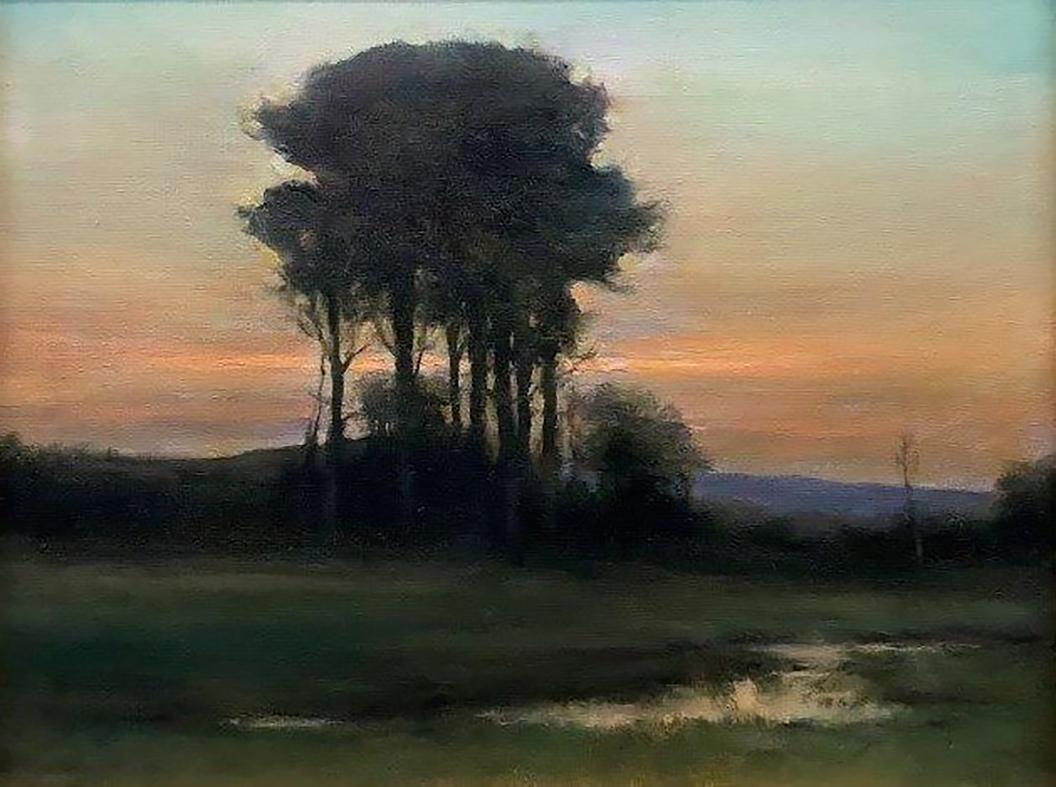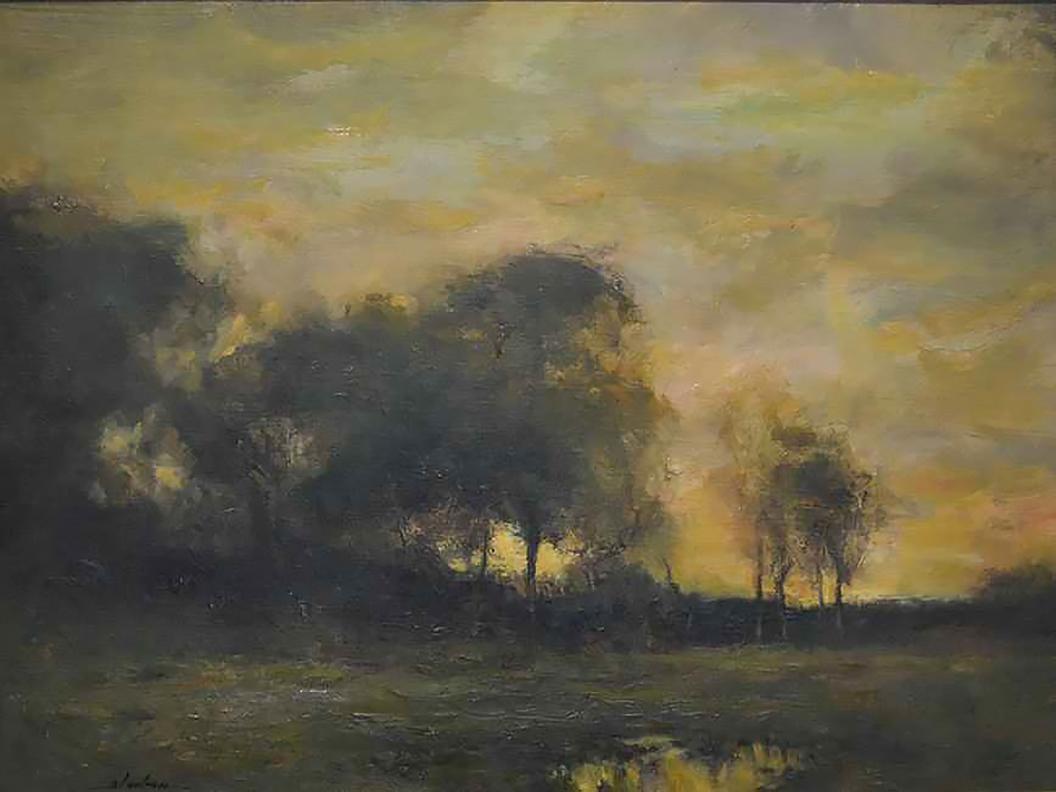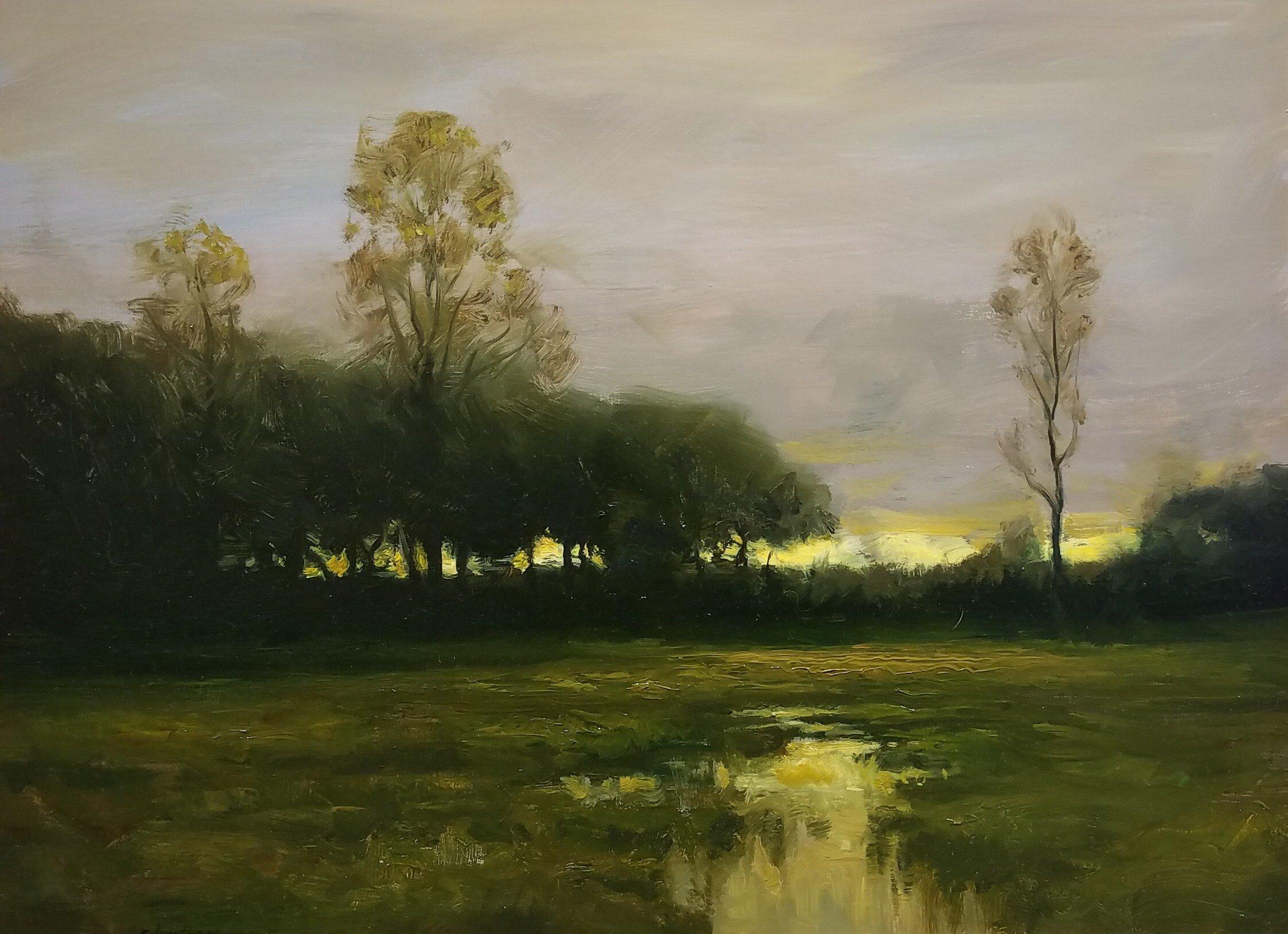Items Similar to "Verdant Summer Landscape, " Olive Parker Black, Tonalism, Female Artist Stream
Want more images or videos?
Request additional images or videos from the seller
1 of 8
Olive Parker Black"Verdant Summer Landscape, " Olive Parker Black, Tonalism, Female Artist Stream
About the Item
Olive Parker Black (1868 - 1948)
Verdant Summer Landscape
Oil on canvas
20 x 30 inches
Signed lower left
An accomplished landscape painter, Olive Black was born in Cambridge, Massachusetts. She studied art with Hugh Bolton Jones at the Art Students League and with William Merritt Chase and Edwin Blashfield at the New York National Academy of Design in New York. She was considered one of Chase's best students and likely attended the Shinnecock Summer School of Art, which became known as Chase's school and was primarily attended by women.
She combined the impressionism learned from him with Barbizon school influence from Jones. She exhibited at the National Academy of Design from 1897 to 1930 and also exhibited in Boston and Philadelphia. To 1910, she lived in Cambridge, Massachusetts and then moved to New York City where she exhibited at the National Academy of Design from 1897 to 1930. She also exhibited with the Boston Art Club, the Art Club of Philadelphia and the Carnegie Institute.
She was a member of the National Association of Women Artists, the New York Society of painters, American Artists Professional League and the Copley Society in Boston.
- Creator:Olive Parker Black (1868 - 1948, American)
- Dimensions:Height: 29 in (73.66 cm)Width: 39 in (99.06 cm)
- Medium:
- Movement & Style:
- Period:
- Condition:
- Gallery Location:New York, NY
- Reference Number:1stDibs: LU1841210631302
About the Seller
5.0
Platinum Seller
These expertly vetted sellers are 1stDibs' most experienced sellers and are rated highest by our customers.
Established in 2021
1stDibs seller since 2022
59 sales on 1stDibs
Typical response time: 1 hour
- ShippingRetrieving quote...Ships From: Larchmont, NY
- Return PolicyA return for this item may be initiated within 3 days of delivery.
More From This SellerView All
- "November, " Bruce Crane, Tonalism Landscape Autumn Scene, American ImpressionismBy Bruce CraneLocated in New York, NYBruce Crane (1857 - 1937) November Oil on canvas 25 x 30 inches Signed lower right Robert Bruce Crane was an American painter. He joined the Lyme Art Colony in the early 1900s. His ...Category
Early 20th Century Tonalist Landscape Paintings
MaterialsCanvas, Oil
- "Last Light, Landscape at Sunset, " William Keith, California Tonalist, ForestBy William KeithLocated in New York, NYWilliam Keith (1838 - 1911) Last Light, Landscape at Sunset Oil on canvas 25 x 30 inches Signed lower right A native of Scotland, William Keith became in the late 19th and early 20th centuries a leading Northern-California landscape artist. In fact, he was so well known that he is referred to as the "Dean of California painters." His romanticized views of nature found much favor among the culturally aspiring citizens of San Francisco and hung in many foyers and dining rooms in their elegant homes. He completed thousands of paintings and drawings, and many of them were lost in his studio in the fire of 1906. His early works are dramatic mountainscapes in a realistic style adopted from the Dusseldorf School of Germany. The paintings of the last two decades of his life are looser and obviously influenced by his exposure in France to the Barbizon School of landscape painters, who were the first colony of painters to complete paintings "en plein air," or directly from nature rather than in studios. A forerunner of Impressionism, this style also included Tonalism espoused by Barbizon painter Camille Corot [1796-1875] and also apparent in Keith's later works, which are darker, smaller, and much more intimate with emphasis on mood. Born in Aberdeenshire, Scotland, Keith came to New York with his family and, apprenticed to a wood engraver. In 1859, he moved to San Francisco where he worked for an engraver and later set up his own engraving business. Studying with Samuel Marsden Brookes in 1863, he determined to become a painter. He married artist Elizabeth Emerson and did watercolor painting with her guidance. In 1868, he became a full-time painter, and that same year was commissioned to paint scenes along the Columbia River including Mount Hood. By August 1869 he had sold enough paintings to finance an extended journey to the East Coast and Europe including Dusseldorf, Germany throughout most of 1870, studying with Albert Flamm. After a visit to Paris, he expressed great admiration for "the modern school of French landscape painting including the Barbizon School. During the winter of 1871-1872, the Keiths lived in Boston where they shared a studio with William Hahn. Keith's work received critical acclaim there and in New York at the National Academy of Design. In 1872, he returned to San Francisco. A friendship with naturalist John Muir exposed Keith to many remote places and in-depth knowledge of nature. During the 1870s, he painted several "epic" eight by ten-foot High Sierra views. He also visited Alaska, and his paintings of Alaska were exhibited upon his return to San Francisco in a show at the Bohemian Club, titled 'Dreams of Alaska'. Keith's Alaska works are significant because they are not close transcriptions of actual scenery, but rather are fantasies inspired by Alaska. They are important as they represent a major break from the documentary tradition in landscape painting of Alaska, as they show an interest in capturing its spirit versus just the topography. The first wife of William Keith died in 1882, and in 1883, he married Mary McHenry, the first woman graduate of Hastings Law School. They soon went to Europe, and Keith studied portrait painting in Munich with consultations from J. Frank Currier and Carl Marr for two years. Keith then settled for the remainder of his life in Berkeley, California, at 2207 Atherton Street. His studio was in San Francisco where he commuted daily, painted prolifically, and taught many classes, mostly for aspiring female artists . In 1891, he shared his studio for several weeks with East Coast Tonalist George Inness, Sr. [1825-1894]. Both men painted in a similar style and were followers of the mystical teachings of Swedenborg. Among the locations where Inness and Keith painted together were Monterey and Yosemite, and it was reported they discussed art from every possible angle. Under Inness' influence, Keith painted more than ever in a Barbizon-influenced vein with many sunset and twilight scenes. By the early 1900s, Keith was likely one of the wealthiest artists in the United States and certainly earned the most money of any California-based artist. People from all over the world sought out his studio where it was said that he would specially select a painting for a client from behind a black velvet curtain...Category
Late 19th Century Tonalist Landscape Paintings
MaterialsOil, Canvas
- "Spring Landscape Along the Stream, " Hugh Bolton Jones, Antique Tonalist SceneBy Hugh Bolton JonesLocated in New York, NYHugh Bolton Jones (1848 - 1927) Spring Landscape Along the Stream Oil on canvas 22 x 30 inches Signed lower right A Baltimore, Maryland native, Hugh...Category
Late 19th Century Tonalist Landscape Paintings
MaterialsCanvas, Oil
- "Field at Dusk, " Bruce Crane, Tonalist Landscape View in Late Autumn at DuskBy Bruce CraneLocated in New York, NYBruce Crane Field at Dusk Signed lower right Oil on canvas 22 x 30 inchesCategory
1890s Tonalist Landscape Paintings
MaterialsCanvas, Oil
- "Autumn Landscape, " Bruce Crane, Tonalist American Impressionist Fall SceneBy Bruce CraneLocated in New York, NYBruce Crane (1857 - 1937) Autumn Landscape Oil on canvas 25 x 30 inches Signed lower right Robert Bruce Crane was an American painter. He joined the Lyme Art Colony in the early 190...Category
Early 20th Century Tonalist Landscape Paintings
MaterialsCanvas, Oil
- "Mount Rockwell, Glacier National Park, Montana, " Mountain Lake Landscape ViewBy Charles Warren EatonLocated in New York, NYCharles Warren Eaton (1857 – 1937) The Shadow of Mount Rockwell, Glacier National Park, Montana, 1921 Oil on canvas 20 x 24 inches Signed lower right: CHAS WARREN EATON. Provenance: The artist The Macbeth Gallery, New York Private Collection Sotheby's New York, American Art, April 14, 1989 ConocoPhillips, Houston Simpson Galleries, Houston, Fine Art & Antiques, May 18, 2019, Lot 447 Exhibited: New York, The Macbeth Gallery, Paintings of Glacier National Park by Charles Warren Eaton, December 13, 1921 - January 2, 1922, no. 2. Literature: "Two Exhibitions at Macbeth's," American Art News, New York, Vol. XX, No. 10, December 17, 1921. A contemporary critic wrote that the paintings of Charles Warren Eaton appeal to “the dreamers who find in them the undiscovered scenes in which their fancy long has dwelt.” Eaton’s contemplative landscapes exude a spiritual quality that moves the observer into a similar frame of mind. He loved to depict the ethereal light of dawn and dusk in late autumn or winter, usually without any reference to human or animal figures or buildings. These Tonalist paintings, with their subdued palette and relatively intimate scale, marked a definite break with the fading popularity of the panoramic and romantic views of the Hudson River School painters. Charles Warren Eaton was born in Albany, New York to a family of limited means. He began painting while working in a dry-goods store. At age 22, he enrolled at the National Academy of Design in New York City and then studied figure painting at the Art Students League. By 1886, he was successful enough to quit his day job and make a living as a landscape painter. That year, he traveled to Europe with fellow Tonalist painters Leonard Ochtman and Ben Foster. In France, Eaton visited popular artist’s spots such as Paris, Fontainebleau and Grez-sur-Loing, and fell in love with the loose brushwork and moody style of French Barbizon painting. Returning to the United States, Eaton fell under the spell of George Inness, the foremost exponent of Barbizon style in the United States. In 1888, Eaton settled near Inness in Bloomfield, New Jersey, where Eaton lived until his death in 1937. In this period, he painted shadowy and ambiguous landscapes inspired by rural scenery in the northeastern United States. His signature theme was a cropped view of the branches, trunks, and foliage of a pine grove silhouetted against a delicately illuminated sunset or moonlit sky. He painted this vision so often between 1900 and 1910 that he picked up the sobriquet ‘‘The Pine Tree Painter.” After 1910, Eaton responded to the popularity of Impressionism by using brighter colors and painting sunlit daytime scenes. In 1921, he was hired to paint Glacier Lake, in Glacier National Park by the Great Northern Railroad Company as part of their ‘See America First’ campaign. He produced more than 20 paintings, among the artist's last works, that now poignantly remind viewers of the vast disappearing glaciers. Eaton tended to approach this mountain scenery from an oblique vantage point; he liked to capture small episodes, showing mountaintops nearly obscured by dramatically attenuated screens of fir trees. Eaton, like many Tonalist artists of his generation such as Henry Ward Ranger, John Francis Murphy, and Charles Melville Dewey...Category
1920s Tonalist Landscape Paintings
MaterialsCanvas, Paint, Oil
You May Also Like
- Sunset, 1910 by Hudson Mindell Kitchell (American, 1864-1944)Located in New York, NYAn early 20th century nocturne by Hudson Mindell Kitchell (1864-1944), Sunset, 1910 features a figure sitting beneath a tree beside a body of w...Category
20th Century Tonalist Landscape Paintings
MaterialsCanvas, Oil
- Tonalist Hills and RiverLocated in Hillsborough, NCThe technique of American Tonalism is evident in this oil painting on canvas from the early 20th century/late 19th century. Hues of muted greys cre...Category
20th Century Tonalist Landscape Paintings
MaterialsCanvas, Oil
- Dennis Sheehan, "Evening Prelude", Moody Sunset Tonalist Landscape Oil PaintingBy Dennis SheehanLocated in Saratoga Springs, NYThis piece, "Evening Prelude", by artist Dennis Sheehan is a 14x18 oil painting on canvas featuring a marshy green landscape at dusk. This moody painting shows tree line at the horiz...Category
2010s Tonalist Landscape Paintings
MaterialsCanvas, Oil
- Dennis Sheehan, "Glowing Hedgerow", Moody Tonalist Landscape Oil PaintingBy Dennis SheehanLocated in Saratoga Springs, NYThis piece, "Glowing Hedgerow", by artist Dennis Sheehan is a 18x24 oil painting on canvas featuring a marshy green landscape at dusk. This moody painting shows tree line at the hori...Category
2010s Tonalist Landscape Paintings
MaterialsCanvas, Oil
- Dennis Sheehan, "Changing Seasons" 12x12 Autumn Landscape Oil Painting on CanvasBy Dennis SheehanLocated in Saratoga Springs, NYThis piece, "Changing Seasons", by artist Dennis Sheehan is a 12x12 oil painting on canvas featuring a marshy green landscape in hazy autumn light. Changing foliage highlights the trees in colors of rusted reds and ochres, reflecting in the water below. About the artist: Dennis Sheehan's work is often described as reminiscent of the great masters of the Barbizon School, in France in the 19th century, and the American Tonalist. Born in Boston in 1950, he has works in major public and private collections, including the White House. His work has been featured in many publications including the featured cover of American Artist. Dennis Sheehan received his training in the best traditions of the Boston School, studying at the Vesper George School of Art and the Montserrat School of Visual Art. He also studied with two of R.H. Gammell's former students, Robert Cormier...Category
2010s Tonalist Landscape Paintings
MaterialsCanvas, Oil
- Dennis Sheehan, "Across the Marsh", 18x24 Tonalist Landscape Oil PaintingBy Dennis SheehanLocated in Saratoga Springs, NYThis piece, "Across the Marsh", by artist Dennis Sheehan is a 18x24 oil painting on canvas featuring a marshy green landscape at dusk. This moody painting shows tree line at the hori...Category
2010s Tonalist Landscape Paintings
MaterialsOil, Canvas
Recently Viewed
View AllMore Ways To Browse
Oliver Brown
Philadelphia Landscape
Antique Summer
Antique Olive
Female Landscape Artist
Tonal Art
Stream Landscape
Tonal Painting
Tonalism Paintings
Olive Oil
Signed By Oliver
Black Female Painter
American Female Landscape Paintings
Tonalism Landscape
Tonal Landscape
Oil Tonal
Tonal Oil Paintings
Tonalism Landscape Painting





